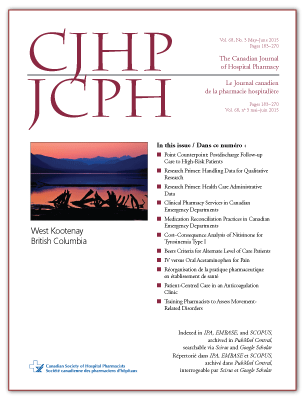Clinical Pharmacy Services in Canadian Emergency Departments: A National Survey
DOI:
https://doi.org/10.4212/cjhp.v68i3.1452Keywords:
emergency department, pharmacist, Canada, survey, pharmacy, technician, service des urgences, pharmacien, sondage, pharmacie, technicienAbstract
ABSTRACT
Background: Providing clinical pharmacy services in emergency departments (EDs) is important because adverse drug events commonly occur before, during, and after ED encounters. Survey studies in the United States have indicated a relatively low presence of clinical pharmacy services in the ED setting, but a descriptive survey specific to Canada has not yet been performed.
Objectives: To describe the current status of pharmacy services in Canadian EDs and potential barriers to implementing pharmacy services in this setting.
Methods: All Canadian hospitals with an ED and at least 50 acute care beds were contacted to identify the presence of dedicated ED pharmacy services (defined as at least 0.5 full-time equivalent [FTE] position). Three different electronic surveys were then distributed by e-mail to ED pharmacy team members (if available), pharmacy managers (at hospitals without an ED pharmacy team), and ED managers (all hospitals). The surveys were completed between July and September 2013.
Results: Of the 243 hospitals identified, 95 (39%) had at least 0.5 FTE clinical pharmacy services in the ED (based on initial telephone screening). Of the 60 ED pharmacy teams that responded to the survey, 56 had pharmacists (27 of which also had ED pharmacy technicians) and 4 had pharmacy technicians (without pharmacists). Forty-four (79%) of the 56 ED pharmacist services had been established within the preceding 10 years. Order clarification, troubleshooting, medication reconciliation, and assessment of renal dosing were the services most commonly provided. The large majority of pharmacy managers and ED managers identified the need for ED pharmacy services where such services do not yet exist. Inadequate funding, competing priorities, and lack of training were the most commonly reported barriers to providing this service.
Conclusions: Although the establishment of ward-based pharmacy services in Canadian EDs has increased over the past 10 years, lack of funding and a lack of ED training for pharmacists were reported as significant barriers to the expansion of this role in most hospitals.
RÉSUMÉ
Contexte : Offrir des services de pharmacie clinique dans les services des urgences est important, car des événements indésirables liés aux médicaments se produisent fréquemment avant, pendant et après y avoir séjourné. Des études par sondage réalisées aux États-Unis font état d’une présence relativement faible des services de pharmacie clinique dans les services des urgences. Malheureusement, aucune enquête descriptive n’a été menée au Canada à ce jour.
Objectifs : Dresser le portrait actuel des services de pharmacie au sein des services des urgences du Canada et présenter les obstacles potentiels à l’établissement de services de pharmacie dans ce milieu.
Méthodes : On a communiqué avec l’ensemble des hôpitaux canadiens disposant d’un service des urgences et d’au moins 50 lits de soins de courte durée afin de savoir s’ils profitaient de services de pharmacie consacrés au service des urgences (soit au moins 0,5 d’un poste équivalent temps plein). Trois différents sondages électroniques ont ensuite été envoyés par courriel : un aux membres du personnel de pharmacie affectés aux services des urgences (le cas échéant); un aux gestionnaires de pharmacie (des hôpitaux sans équipe de pharmacie au service des urgences); et un aux gestionnaires des services des urgences (de tous les hôpitaux). Les sondages ont été remplis entre juillet et septembre 2013.
Résultats : Des 243 hôpitaux recensés, 95 (39 %) avaient au moins 0,5 d’un poste équivalent temps plein pour la prestation de services de pharmacie clinique au service des urgences (résultat établi au moyen d’une présélection téléphonique). Parmi les 60 équipes de pharmacie affectées au service des urgences ayant répondu au sondage, 56 disposaient de pharmaciens (et parmi celles-ci, 27 comptaient aussi sur des techniciens en pharmacie) et 4 étaient composées exclusivement de techniciens en pharmacie. Quarante-quatre (79 %) des 56 équipes comprenant des pharmaciens avaient été mises en place au cours des dix dernières années. La clarification des ordonnances, le dépannage, l’établissement de bilans comparatifs des médicaments et l’évaluation de l’ajustement posologique chez les insuffisants rénaux représentaient les services les plus souvent offerts. La vaste majorité des gestionnaires de pharmacie et des gestionnaires des services des urgences ont souligné la nécessité d’avoir des services de pharmacie au service des urgences dans les établissements où il n’y en avait pas encore. Le manque de financement, le nombre foisonnant de priorités et l’insuffisance de formation représentaient les éléments faisant le plus souvent obstacle à l’instauration de ce service selon les répondants.
Conclusions : Bien que la mise en place de services de pharmacie clinique consacrés aux services des urgences ait augmenté au Canada durant les dix dernières années, le manque de financement et l’insuffisance de formation des pharmaciens pour le travail au service des urgences ont été présentés comme étant d’importants obstacles à l’accroissement de ce rôle dans la plupart des hôpitaux.
Downloads
Published
Issue
Section
License
Copyright © Canadian Society of Healthcare-Systems Pharmacy.
After publication of a manuscript in the CJHP, the authors of the manuscript must obtain written permission from the CSHP (publications@cshp.ca) before reproducing any text, figures, tables, or illustrations from the work in future works of their own. If a submitted manuscript is declined for publication in the CJHP, all said rights shall revert to the authors. Please note that any forms (e.g., preprinted orders and patient intake forms) used by a specific hospital or other health care facility and included as illustrative material with a manuscript are exempt from this copyright transfer. The CJHP will require a letter from the hospital or health care facility granting permission to publish the document(s).










